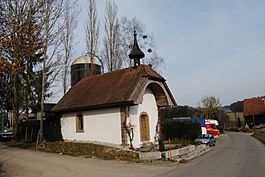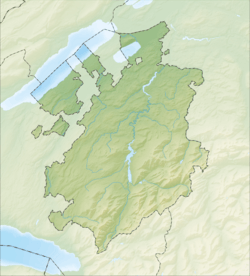Chésopelloz facts for kids
Quick facts for kids
Chésopelloz
|
||
|---|---|---|
 |
||
|
||
| Country | Switzerland | |
| Canton | Fribourg | |
| District | Sarine | |
| Area | ||
| • Total | 1.67 km2 (0.64 sq mi) | |
| Elevation | 620 m (2,030 ft) | |
| Population
(Dec 2015)
|
||
| • Total | 123 | |
| • Density | 73.7/km2 (190.8/sq mi) | |
| Postal code |
1720
|
|
| Surrounded by | Autafond, Avry, Belfaux, Corminboeuf, Noréaz, Ponthaux | |
Chésopelloz (say "shay-zoh-peh-LOH") was once a small village in Switzerland. It was located in the Fribourg region, which is called a canton. Chésopelloz was part of the Sarine district. On January 1, 2017, Chésopelloz joined with a nearby village called Corminboeuf to become one larger community.
Contents
A Glimpse into the Past
Chésopelloz has a long history! It was first mentioned in old documents way back in 1229. Back then, its name was written as Chissapenlo.
Where is Chésopelloz?
This former village was part of the Sarine district in Switzerland. It was made up of three smaller areas, often called hamlets.
Land Use in Chésopelloz
In 2009, Chésopelloz covered an area of about 1.6 square kilometers (0.6 square miles). Most of this land, about 68.5%, was used for farming. This means fields for crops and areas for animals to graze.
About 26.5% of the land was covered by forests. The remaining 6.8% was built-up areas, like houses, roads, and other buildings. A very small part, 0.6%, included rivers or lakes.
What Does the Coat of Arms Mean?
The coat of arms for Chésopelloz is a special symbol. It is split into two parts. The top part is blue and shows a golden rooster walking, with a red comb and wattle. The bottom part is gold and has three red roses with green leaves and centers.
Who Lived in Chésopelloz?
In 2015, Chésopelloz had a population of 123 people. Over ten years, from 2000 to 2010, the population grew by about 9.6%. This growth happened because more people moved into the village and more babies were born than people who passed away.
Languages Spoken
Most people in Chésopelloz speak French. In 2000, about 82.6% of the population spoke French as their main language. The second most common language was German, spoken by about 13.8% of the people. A small number, 1.8%, spoke Italian.
Age Groups
In 2000, the population of Chésopelloz included:
- Children and teenagers (0–19 years old) made up about 31.2%.
- Adults (20–64 years old) made up about 56%.
- Seniors (over 64 years old) made up about 12.8%.
Homes and Households
In 2000, there were 37 private homes in Chésopelloz. On average, about 2.9 people lived in each home. Most of the apartments were lived in all year round.
The historical population is shown in the chart below:

What Did People Do for Work?
In 2010, the unemployment rate in Chésopelloz was very low, at 1.6%. This means almost everyone who wanted a job had one.
Job Sectors
In 2008, people in Chésopelloz worked in different types of jobs:
- Primary Sector: 24 people worked in this sector, mainly in agriculture (farming). There were 8 businesses related to farming.
- Secondary Sector: 4 people worked in this sector, mostly in manufacturing (making things). There was 1 business in this sector.
- Tertiary Sector: 5 people worked in this sector, which includes services. There were 3 businesses in this sector, like selling cars or working as scientists.
Overall, 58 residents of Chésopelloz had jobs. About 36.2% of the workers were women.
Religion in Chésopelloz
Based on the 2000 census, most people in Chésopelloz were Roman Catholic, about 76.1%. About 11% belonged to the Swiss Reformed Church. A small number of people, about 1.83%, were Islamic. About 11.01% of the population did not belong to any church.
Education in Chésopelloz
Education is very important in Switzerland. In Chésopelloz, about 32.1% of the population had finished upper secondary education. This is like high school. About 16.5% had gone on to higher education, like university or a specialized college.
School System in Fribourg
The Canton of Fribourg has a specific school system:
- It starts with one year of optional Kindergarten.
- Then, six years of Primary school are required.
- After that, students go to three years of required lower Secondary school. Here, students are grouped based on their abilities.
- Next, students can choose to attend a three or four-year optional upper secondary school. This can be a gymnasium (which prepares students for university) or a vocational program (which teaches job skills).
- After upper secondary school, students can go to a Tertiary school (like university) or continue with an apprenticeship (learning a trade on the job).
In the 2010–11 school year, no students attended school directly in Chésopelloz. Instead, 19 students from Chésopelloz went to schools in other nearby villages. These students were in various levels, from kindergarten to vocational programs and even university.




